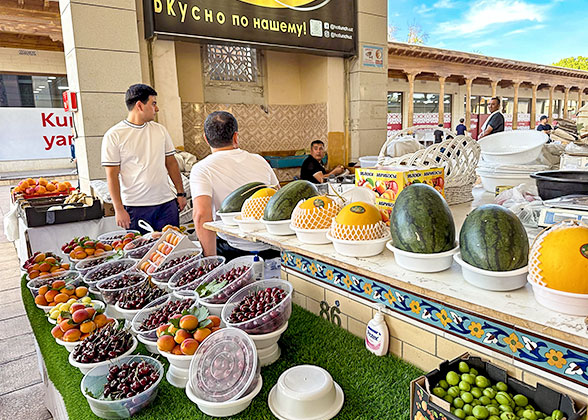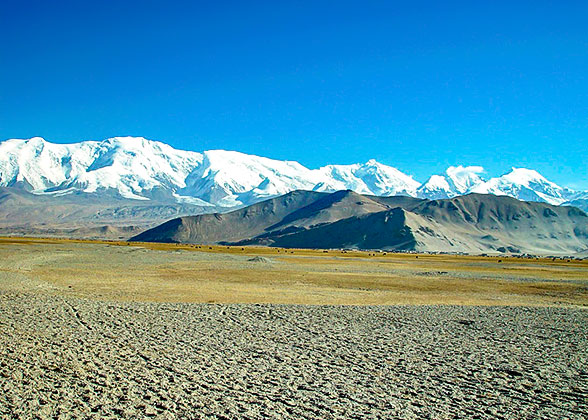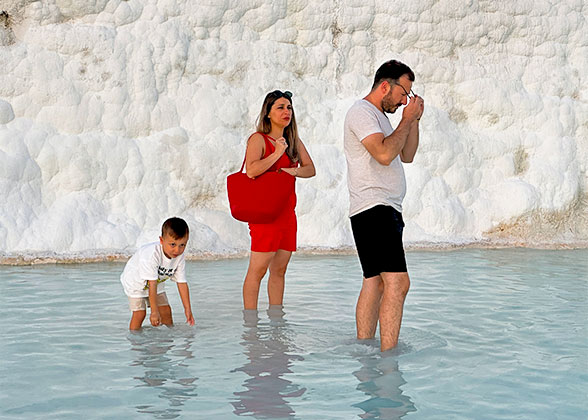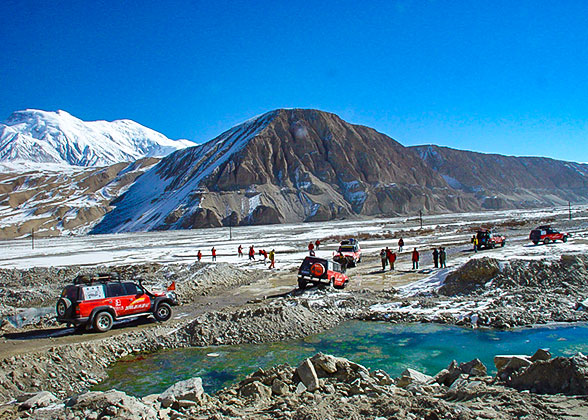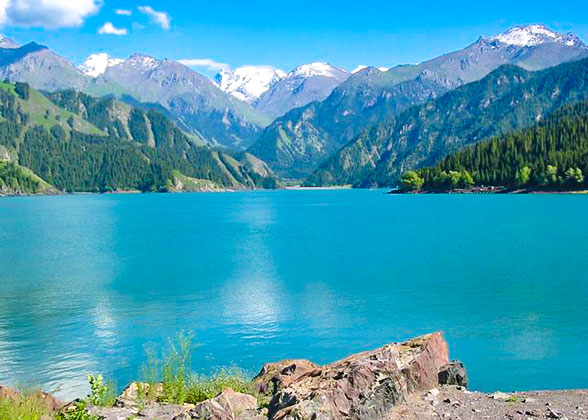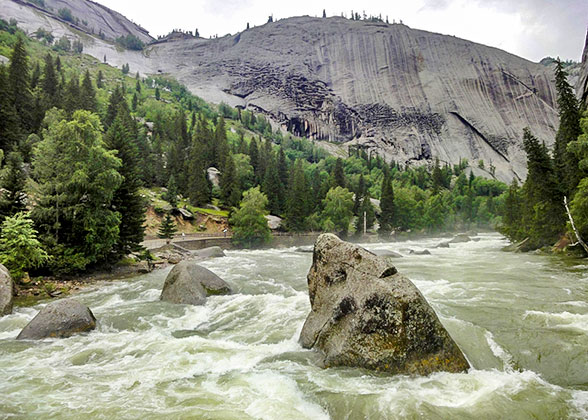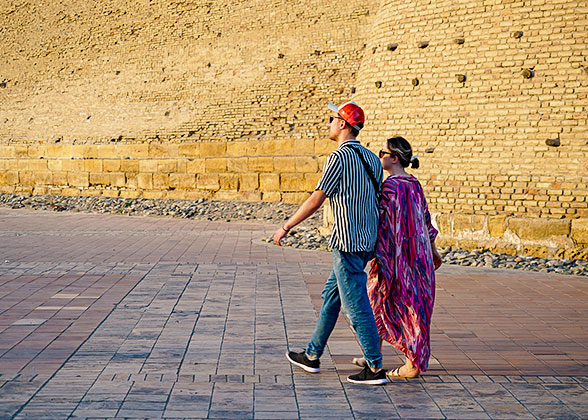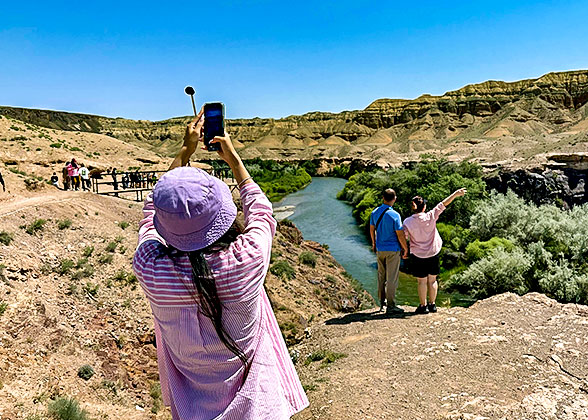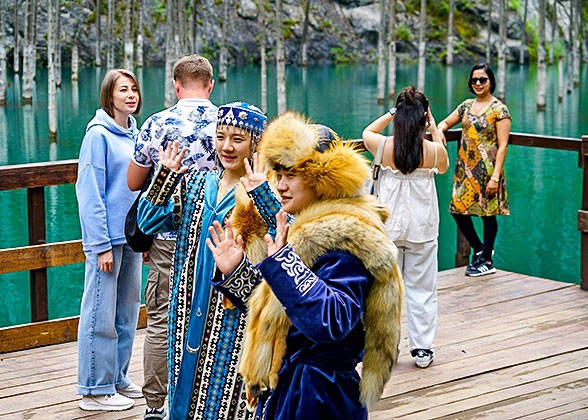Day 1: Dushanbe Airport Pick-up; Visit National Museum of Antiquities, Victory Park & Botanical Garden
Welcome to mountainous Tajikistan! Upon arrival at Dushanbe airport, meet your private guide and the driver, who will escort you to the hotel downtown. As Central Asia’s smallest country, Tajikistan is widely covered by the Pamir Mountains, with more than half of its land lying at an altitude of over 3,000 meters (9,842 feet)! Along the way to the hotel, the snow-capped peaks around the city and the central avenue lined with beautiful roses and greenery will catch your eye.
After a short break, kick off your 12 days Tajikistan tour itinerary with the National Museum of Antiquities, which houses a large collection of authentic historical artifacts, including pottery, sculptures, and paintings, as well as the 13-meter (43-foot) long, 6.5-ton Buddha in Nirvana, the most treasured piece of the museum, bearing testimony to Buddhism’s being prevalent in Central Asia before Islam rose in the 8th century. Please note that visitors are required to remove their shoes, while the museum also provides shoe covers, and you can ask the staff for them.
Then, head to Victory Park, which was built to commemorate the Soviet-Tajik fallen soldiers in World War II. Nestled on a verdant hill, it beckons local residents and visitors with fresh air and a laid-back atmosphere, as well as panoramic views of the city.
Afterward, proceed to the Botanical Garden to admire native and exotic trees and shrubs, many of which are threatened species. Moreover, from late June to July, people would celebrate the lively Tirgon Festival here to pray for rain and a good harvest, and vendors selling high-quality apricots, plums, cherries, peaches, grains and beans turn up in hordes.
► For Your Information
1. GBAO Permit: All visitors entering the Pamir region are required to obtain the permit online in advance, which can be applied for during the e-visa process, even though you may not need a visa. Keep several copies, as we’ll pass by several checkpoints.
2. Currency: Cash is king! Bring US dollars and exchange them for Tajikistani somoni in major cities like Dushanbe, as there will be few ATMs or exchange points in small towns.
3. SIM Card & Internet: Be prepared for the poor signal in the Pamir Plateau; nevertheless, a local SIM card is necessary to help you stay connected. Consider purchasing a MegaFon SIM card online, which works well in the Wakhan Corridor. The 25 GB plan for 1 month costs around TJS 100 (USD 10).
4. Best Time to Visit: May to October is generally good for a Pamir expedition, and the best time is from June to September, when the weather is warmer and the road conditions are good; roads may be subject to avalanches or collapses in extreme cold winters.
Accommodation: Hotel Atlas Dushanbe (4 stars) or similar
|
Day 2: Dushanbe: Hisor Fortress, Rudaki Park, National Museum, Navruz Palace & Local Bazaar
This morning, we’ll drive for an hour to visit the hilltop Hisor Fortress in the western suburbs of Dushanbe. Aged around 2,500, it has survived tumultuous times through numerous restorations and played a vital role in the Silk Road, an ancient trade route connecting Asia and Europe. Stroll along the old city walls, pass by stone fortified towers, madrasas, a mosque, and the orderly camel lodges, and enjoy a bird's-eye view of the fortress, imagining the prosperous trading times the camel caravans once brought about. Then, return to downtown and wander around the shady Rudaki Park, which is dedicated to Abdullah Rudaki (858-941), the founder of Persian classical literature. It is always in full swing with locals enjoying laid-back moments beside the fountains, the open-air theater and gardens. On the north of the park stands the statue of Rudaki, and behind it is a semicircular arch with mosaics of stars. Afterward, admire some of the city's landmarks from the exterior: the National Library, Central Asia’s largest library that has an overall design like an open book; the Palace of Nations, locally regarded as the new presidential palace; the Stele with the Emblem of Tajikistan, a commemorative column for the 20th anniversary of Tajikistan's independence; the Parliament; the Ministry of Internal Affairs; and the Dushanbe Flagpole, the world’s second tallest flagpole, measuring 165 meters (540 feet) high! At the nearby Somoni Square, pay your respects to the Statue of Ismoil Somoni, revered as the "Father of the Tajik Nation", who led his people to independence during his charge of the Samanid Empire (819-999). Next, visit the National Museum and learn about the ancient, medieval and modern histories of Tajikistan from abundant exhibits, including pottery, jewelry, unique musical instruments, and handicrafts. Moreover, marvel at the murals that vividly depict the life and customs of the Central Asian residents during the 6th-8th centuries, marked by red, yellow, and brown tones. Then, be spellbound by the grand Navruz Palace, where national and international conferences are held. Each of its 12 rooms is in a distinctive design. For example, the magnificent Zarandud Hall is decorated with massive gold leaf and a huge crystal chandelier, and the Guliston Hall features intricate floral carvings on the ceiling and walls. At last, head to the Asian Bazaar, which is indispensable for experiencing the indigenous life in Central Asia. Soak up the lively atmosphere and mingle with the locals, bargaining with vendors for colorful and fresh products like spices, nuts, and fresh fruits. Feel free to try the local snacks like naan bread, plov (a rice dish), and samosas (grilled buns) on your own. By the way, you may find that most of the vendors are female, as lots of Tajik men would go abroad to work, especially to Russia, making labor export a vital part of Tajikistan’s economy. Meal: Breakfast Accommodation: Hotel Atlas Dushanbe (4 stars) or similar
|
Day 3: Drive 8 Hours to Kalai-Khumb, Stop by Nurek Reservoir & Shuraba Pass
★ Legendary Pamir Plateau Tour along M41 HighwayToday, the Pamir Plateau, dubbed the "Roof of the World", awaits! After breakfast, we’ll head toward Kalai-Khumb town by an 8-hour drive along the legendary M41 Highway (Pamir Highway), the second-highest highway in the world. The highway connects Dushanbe and Osh in Kyrgyzstan, stretching over 1,200 km (746 mi), with elevations ranging from over 900 meters (2,952 feet) to nearly 4,600 meters (15,091 feet). We have especially arranged the highway’s most highlighted section for you, from Dushanbe to Lake Karakul. The long drive may sound nerve-racking, but it provides you with breathtaking views! There are rare modern service spots along the road, but you’ll find avalanche gullies, paths made by wild sheep, and the barren land that has been inhabited by the nomads for generations.
En route, stop by a viewing platform to appreciate the Nurek Reservoir, whose azure water dotted with rocks and small islands lies peacefully in the expansive valley. It’s Tajikistan’s largest reservoir and one of the most favored summer vacation spots for Dushanbe residents.
Afterward, drive through Shuraba, a pass about 2,267 meters (7,437 feet) high located at the border between Tajikistan and Afghanistan. Drive along the Panj River, listening to its surging water roaring in the valley, and catch a glimpse of the Afghans’ daily life across the river. However, please avoid taking photos at the border for safety concerns. After arriving at Kalai-Khumb, check in at the hotel and have a nice dream.
► Preparations for Pamir Expedition
1. Physical Condition: The average altitude of the Pamir Mountains is approximately 4,500 meters (14,763 feet), which easily induces altitude sickness. Please take aerobic exercise to strengthen your heart and lungs and try not to get sick one month before the journey.
2. Equipment: Pack a windbreaker, a down jacket, sunscreen, sunglasses, a hat with a chinstrap, gloves, and hiking boots. Additionally, a power bank and toilet paper are also highly advised.
3. Food: The food along the Pamir is not as diverse and delicious as that in the city, and the most common dishes are naan (a kind of flatbread) and plov (rice dish). You can bring some favorite snacks.
Meal: Breakfast
Accommodation: Karon Palace Hotel Kalai-Khumb (4 stars) or similar
|
Day 4: Drive 7 Hours to Khorog
Today, let’s continue traveling along the M41 Highway to Khorog, the largest city in the Pamirs! When driving along the winding road through the steep mountains, you can catch sight of the picturesque Afghan rural scene across the Panj River, which flows generally from east to west, fed by numerous streams formed by melting snow from the mountains. Apart from the stunning natural scenery, the road features a strong sense of history, as it was once a part of the ancient Silk Road, packed with caravans, where the camel bells from thousands of years ago seem to echo. You may also have a chance to see local children frolicking in the water, villagers leading mules loaded with daily supplies, and border guards on sentry duty... In the small villages along the way live the simple and hospitable Pamiris, aka the Mountain Tajiks, who have led a semi-nomadic and semi-agricultural life for thousands of years.
► Note: A high-performance off-roader and a skilled driver are particularly of vital importance, as the road to Khorog features flat asphalt parts alternating with bumpy gravel sections. Don’t worry! We’ve arranged both for you! And you can bring your neck pillow to make your trip comfy.
Check in at the hotel upon arrival in Khorog, which is surrounded by magnificent snow-capped mountains and boasts a relatively pleasant climate most times of the year. Enjoy some rest or stretch your legs in the nearby Central Park of Khorog by yourself.
Meal: Breakfast
Accommodation: Lal Hotel Khorog (3 stars) or similar
|
Day 5: Drive to Ishkashim; Visit Botanical Garden & Garm Chashma Hot Spring En Route
After breakfast, enjoy a short hike at the Botanical Garden near Khorog, one of the world’s highest of its kind. The towering coniferous woods, rare shrubs, and blooming flowers will add some vibrant colors to your mountain road trip. Afterward, drive southward for 1.5 hours to the Garm Chashma Hot Spring, once a resting spot on the Silk Road. The white natural hot spring at an altitude of approximately 2,400 meters (7,874 feet) is effective against skin diseases and rheumatism. Legend has it that Ali, the Prophet Muhammad's son-in-law, struck the ground with his sword when he fought against the evil dragon, and hot water gushed out, forming the hot spring. If you wish, you can take a hot spring bath on your own. Then, another 2-hour drive leads you to Ishkashim, the starting point of the Wakhan Corridor. Although the roads are quite bumpy, the snow-capped peaks and Tajik and Afghan villages are treats to the soul. You may encounter vendors selling mineral-made necklaces, as the Gorno-Badakhshan Region has been rich in mineral resources such as lapis lazuli since the 14th century. Keep driving until a bridge pops into view, across which lies a town also named Ishkashim in Afghanistan. On Saturdays, villagers from both sides gather on the bridge, set up stalls directly on the ground, and trade spices, colorful clothing, fabrics, carpets, etc. With your passport and GBAO permit, you can glimpse the interesting border market by chance, but sometimes foreign visitors may be refused entry. Upon arriving at Ishkashim, check in at the guesthouse. Since the network signal can be poor from here, you can contact your family in advance to let them know that you are safe. ► Note: Guesthouses on the plateau are generally not specially served for visitors, but are self-built houses, with most courtyards having 3-4 rooms. Sometimes there are only traditional thick mats serving as beds, and the toilet and bathroom are located outside the rooms. Besides, as the heating system may be unstable, it’s advisable to bring a sleeping bag. Meal: Breakfast Accommodation: Bahodur Guesthouse, Ishkashim or similar Pamir Plateau Garm Chashma Hot Spring
|
Day 6: Wakhan Corridor: Explore Vrang, Yamg & Langar Villages, along with Fortresses & Hot Springs
★ Drive into the Fold of the Earth - Wakhan Corridor!Today, we’ll explore the Wakhan Corridor, which was once a significant part of the ancient Silk Road, lying between the soaring Pamir Mountains and the perilous Hindu Kush peaks, with the Wakhan River, the upper branch of the Panj River, slowly flowing through the middle. The narrow strip stretching hundreds of miles, with the narrowest part of only about twenty meters, offers more than stunning landforms like rugged snow mountains, sublime river valleys, and bubbling hot springs, but ancient fortresses, Buddhist stupas and ruins, and a string of local villages are also on your bucket list. Besides, the corridor is home to Marco Polo sheep, which feature huge spiral-shaped horns and got their name after the famous Italian traveler in the 13th century, Marco Polo, who once traveled along the Silk Road to Asia.
The first stop will be Yamchun Village. On the way, you might encounter warm-hearted Afghan herders driving Bactrian camels on the opposite bank, who may greet you with a sincere "Hello!" echoing through the valley. Upon arrival in the village, visit Kaahka Fortress, which was built in the 3rd century, and the Yamchun Fortress, which is 3,200 meters (10,500 feet) above sea level and was severely damaged, leaving only the remaining stone walls with 6 circular watchtowers standing still. Continue a 5-minute drive up the fortress and we’ll arrive at the Bibi Fatima Hot Springs, where Marco Polo once allegedly benefited from taking a bath when he was ill.
We’ll also pass by Vrang Village, known for its five-story stone stepped Buddhist pyramid dating back to the 4th-7th centuries. On one of the layers is a sunken pit, which is claimed to be the footprint of the Buddha. Please be careful when walking on the steep slope. Then, proceed to Yamg Village and you’ll be accompanied to visit the hillside House-Museum of Mubarak Kadam Wakhani, in honor of a 19th-century poet highly accomplished in astronomy, music, painting and papermaking. When you approach, several Marco Polo sheep horns atop the gate come into view. Entering the museum, read his manuscript and stone-printed copies, and glimpse the astronomical observation tools he made, such as the sundial and solar calendar.
Continue driving eastward to Langar Village, the largest stopover point tucked away in the Wakhan Valley. Upon arrival, check in at the guesthouse.
Meal: Breakfast
Accommodation: Sash Guesthouse, Langar or similar
|
Day 7: Adventure to Yashilkul & Bulunkul Lakes, Drive 3 Hours to Murghab
Today, our first stop is Petroglyphs in Langar, which vividly depict cute carvings like goats, yaks, and human images, with the oldest ones traceable back to the Bronze Age (1500 BC). Afterward, leave Langar and pass through the 4,344-meter (14,252-foot) high Khargush Pass. Along the way, you may spot chubby, big-eyed, brownish-yellow bobak marmots, a unique species in the Pamirs. Hold your breath and observe the adorable creature!
After a 3-hour drive, arrive at the Yashilkul Lake and Bulunkul Lake, both sitting 3,700 meters (12,139 feet) above sea level, and enjoy a scenic walking tour around them. Yashilkul, considered a sacred lake by the locals, resembles a huge emerald set among the snow-clad summits and the Alichur River, and it is ecological and rich in fish. About 1.5 kilometers away is the Bulunkul Lake, which is as clear as a mirror, reflecting the surrounding mountains, sand dunes, and relatively lush vegetation. The temperature of the water once dramatically plummeted to -63°C (-81.4ºF), making it the coldest region in Tajikistan!
Continue heading northeast, and we will arrive at Murghab in 3 hours. The desolate region is home to dozens of mountains exceeding 6,000 meters (19,685 feet). Tonight, rest at a local hotel in Murghab.
Meal: Breakfast
Accommodation: Pamir Hotel Murghab or similar
|
Day 8: Day Trip to Lake Karakul from Murghab
After breakfast, we’ll head to Lake Karakul through the 4,655-meter (15,272-foot) high AK-Baital Pass, the highest point of M41. The color of the lake varies with light and weather, from deep blue to dark black, hence the name "Black Lake" in the Kyrgyz language. Hike for 1.5 hours to soak up the tranquil atmosphere, and appreciate the stunning scene of the lake reflecting three dramatic peaks: Muztagh Ata (meaning the ‘Father of Ice Mountain’), Kongur Peak, and Kongur Tiube. Around the lake live the hospitable Kyrgyz people, who make a living by herding yaks, sheep, and goats. Every April to October, the lake is lively with Kyrgyz grazing their livestock, while from October to May, it freezes, presenting a vast expanse of white. It’s cold and windy even in summer, with the average temperature being around 5°C (41ºF), so wrap up in your coat, and wear a mask and a hat with a string. At last, we will drive 3 hours back to Murghab. ► Prevention of Altitude Sickness 1. Medication Necessities: Bring an oxygen tank and medicines for anti-altitude sickness, colds, stomach problems, and motion sickness. If you are a first-timer to the plateau or have a history of altitude sickness, you can take preventive medication as advised by your doctor in advance. 2. Gradual Ascent: We’ll take the route gradually, moving from the lower Dushanbe to the higher Pamir areas, leaving you time to adapt to the altitudes. Besides, it’s advisable to walk slowly and avoid running or being overly excited in high-altitude regions. 3. Keep Hydrated: Timely water replenishment improves blood circulation and alleviates altitude sickness, and 1.5 times the usual amount of water intake will be good. 4. Avoid Alcohol: Alcohol may cause dehydration, which can aggravate altitude sickness. Meal: Breakfast Accommodation: Pamir Hotel Murghab or similar Khargush Pass Lake Karakul
|
Day 9: 8-Hour Road Trip from Murghab to Khorog
Today, we’ll backtrack to Khorog via the Pamir Highway and pass by the 4,271-meter (14,012-foot) high bumpy Koitezek Pass. If you feel sick, tell your driver and we’ll stop for a while to let you recover. En route, admire the mighty Ghund River alongside stunning cliffs flowing westwards, green fir trees in the valley, and blue and gray iron roofs scattered around. After reaching Khorog, enjoy a rest or chat with the locals. Khorog has relatively good educational facilities, and lots of young people can speak English. Why not listen to the locals’ storytelling about the city and their lives?
Meal: Breakfast
Accommodation: Lal Hotel Khorog (3 stars) or similar
|
Day 10: Drive 7 Hours from Khorog to Kalai-Khumb
Today, we’ll go back to Kalai-Khumb along the way you came. En route, chase the downstream Panj River and stop at a village on the riverbank to learn about the locals’ lives. Simple white flat- and sloping-roofed cottages stand on the vast land, some of which had weathered into a yellowish color over time, with utility poles nearing. Enter the house decorated with a red and blue carpeted bed and floor, have a chat with the locals, and listen to their stories about the Pamir life, where the warm stove dispels the coldness. Although the average monthly salary of Tajik people is only about TSJ 1,000 (USD 100), the locals are so simple and always treat guests to the best lamb, tea, and naan bread. Children with clear eyes would sit around foreign guests, and if you surprise them with some sweets as a gift, they’ll jump for joy. ► Dinner Recommendation (at your own expense) Perhaps you’re longing for some pasta after having naan bread and plov rice for several days; head to the nearby Oshkhonai Milli restaurant. Sit on the terrace table by the river and enjoy a mountainous dinner while listening to the flowing water and appreciating the vast starry sky. It closes at midnight, and only cash is accepted. Average Cost per Person: TJS 50 (USD 5) Address: FQ4Q+V8R, Kalai-Khumb Meal: Breakfast Accommodation: Karon Palace Hotel Kalai-Khumb (4 stars) or similar Kalai-Khumb Tajikistan Samsa
|
Day 11: Drive 7 Hours from Kalai-Khumb back to Dushanbe
Today, we’re going back to Dushanbe. En route, drive by the Khaburabot Pass, 3,252 meters (10,669 feet) above sea level. This is the first major mountain pass along the Pamir Highway near Dushanbe, with rugged and poorly maintained terrain due to natural disasters like avalanches and landslides. However, you’ll be rewarded with the hill-surrounded scenery along the way: the towering and snowy summits, villages dotted at the foot of the mountains, pale orange mud houses, and industrious and hospitable villagers. After arriving in Dushanbe, check in at the hotel.
► Recommended Evening Activity (at your own expense)
If you are an art enthusiast, consider watching a first-class show at the historic Ayni Opera House, where talented local and international artists perform operas, ballets, and classical music. The building itself blends with Soviet and Tajik classical styles, and the light and music fountain is also magnificent. Be sure to check the schedule on the website in advance.
Cost per Ticket: TJS 30-100 (USD 3-10)
Address: Rudaki Avenue 28, Dushanbe
Meal: Breakfast
Accommodation: Hotel Atlas Dushanbe (4 stars) or similar
|
Day 12: Dushanbe Departure, Airport See-off
Today, your sacred Pamirs tour ends. Your guide and the driver will escort you to Dushanbe International Airport and see you off. Wishing you a nice journey home!
If you’re curious about other popular sites in the mysterious Central Asia, for instance, Bukhara in Uzbekistan, which is hailed as "the oasis in the desert"; the Issyk-Kul Lake in Kyrgyzstan, the world's second largest mountain lake; and the geological wonder "Door to Hell" in Turkmenistan, please feel free to tell us, and we’ll tailor the itinerary according to your preferences!
Meal: Breakfast
|


